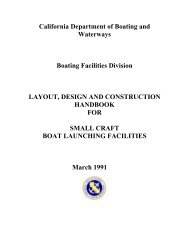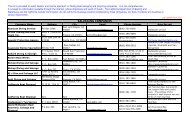EVEREST June, 2013 - California Department of Boating and ...
EVEREST June, 2013 - California Department of Boating and ...
EVEREST June, 2013 - California Department of Boating and ...
You also want an ePaper? Increase the reach of your titles
YUMPU automatically turns print PDFs into web optimized ePapers that Google loves.
Orange County Coastal Regional Sediment Management Plan<br />
constraint period for least tern is generally identified as April 15 to September 15 by USACE,<br />
although it is listed as April 1 to August 30 in RGP 67 (USACE, 2006). The snowy plover<br />
breeding season constraint period may be identified as March 1 to September 15 or September<br />
30 (RGP 67). Generally, the grunion constraint period extends from March 1 through August<br />
31. Verification <strong>of</strong> constraint periods <strong>and</strong> work windows for coastal projects conducted in<br />
Orange County should be verified during project permitting, as applicable. Different color<br />
shading in the table denotes the months associated with the referenced seasonal periods.<br />
Table B.1<br />
Summary <strong>of</strong> Environmental Constraint Periods by Species <strong>and</strong> Season<br />
SEASON<br />
Fall-Winter<br />
Spring<br />
Summer<br />
Species<br />
Grunion – spawning<br />
Least Tern –<br />
breeding/nesting<br />
Snowy Plover –<br />
breeding/nesting<br />
Snowy Plover -<br />
wintering<br />
MONTH<br />
J F M A M J J A S O N D<br />
Relevant Sensitive Species Constraint Periods<br />
For projects scheduled during the spring <strong>and</strong> summer construction window (between March 1<br />
<strong>and</strong> September 30), pre-construction survey assessment <strong>and</strong> coordination with resource <strong>and</strong><br />
regulatory agencies may be necessary to assess habitat suitability for grunion spawning <strong>and</strong><br />
impact considerations for sensitive species (e.g., least terns, snowy plovers), as applicable,<br />
depending on environmental conditions <strong>and</strong> proximity to sensitive resources. Potential impact<br />
considerations include project schedule, interference with spawning, burial <strong>of</strong> eggs, sediment<br />
compatibility, constructed beach slope, <strong>and</strong> turbidity. Beach nourishment has the potential to<br />
enhance spawning habitat in erosive beach areas (SAIC, 2006).<br />
RSM projects would require consultation between the US Army Corps <strong>of</strong> Engineers (USACE)<br />
<strong>and</strong> US Fish <strong>and</strong> Wildlife Service (USFWS) or National Marine Fisheries Service (NMFS) under<br />
Section 7 <strong>of</strong> the Endangered Species Act if activities have the potential to affect least tern or<br />
snowy plover during the breeding season, critical habitat <strong>of</strong> snowy plover, or interfere with the<br />
movement or behavior <strong>of</strong> other sensitive wildlife (e.g., endangered sea turtles). Coordination<br />
with the USFWS should occur for projects located within two miles <strong>of</strong> least tern breeding<br />
colonies. Mitigation measures (e.g., monitoring, protective measures) may be necessary to<br />
conduct beach nourishment during constraint periods depending on project- <strong>and</strong> site-specific<br />
conditions.<br />
Everest International Consultants, Inc. B.5




